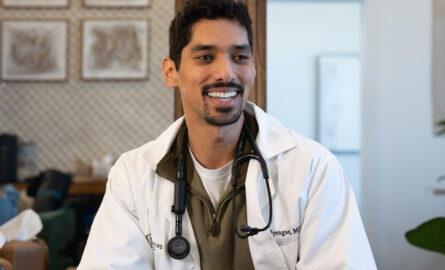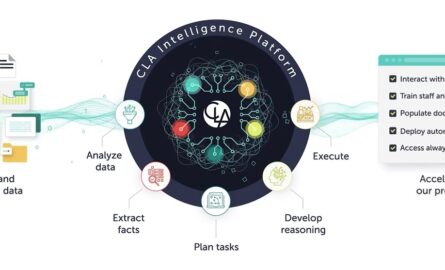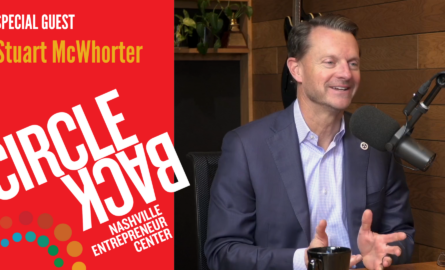Live Session Recap

The final, in-person session kicked off on a beautiful Nashville morning with a very energetic greeting from Nashville Entrepreneur Center’s Jeremy Raley. After a quick intro, Jane Allen, CEO of Nashville Entrepreneur Center, echoed Jeremey’s excitement and opened the floor up to eVisit’s Co-founder and CEO, Bret Larsen.
Larsen set the stage for the day, stressing the importance of a holistic approach to telehealth that includes way more than two-way video. Additionally, he shared that this next phase of telehealth is about operationalizing, making it “usable for everyone from my 69-year-old mother to my 9-year-old son.”
After finishing off some coffee and feeling energized by a great start, the session shifted to a keynote followed by several exciting panel discussions that brought together Nashville’s healthcare heavy-hitters and innovators from around the country.
The Trajectory Of Healthcare Delivery
Paul Keckley
Managing Editor / The Keckley Report
Nashvillian Paul Keckley immediately challenged the audience to look at the long-term goals of where we hope to see healthcare grow. He shared his belief that there hasn’t been enough time spent on the long-term trajectory of the industry.
“I do not believe the future of the system is a repeat of the past,” Keckley said.
He also touched on the energy around healthcare in Washington DC but said that campaign calendars do not define the trajectory of healthcare. Lastly, he wrapped up by sharing his framework for examining the system and its future.
Telehealth and the Digital Patient Experience in the Future of Healthcare at HCA
Christopher Northam, VP, Enterprise Telehealth / HCA
Jessa Kelley, VP of Strategy and Innovation / HCA Healthcare
Kelly Nye, VP of Digital Strategy and Development / HCA Healthcare
Nye said that “Amazon has us in the palm of their hands” and that traditional healthcare organizations likely cannot compete with their user experience or even data aggregation capabilities. This, she shared, is why partnerships are going to be so vital in the healthcare space. “We can’t do it alone.”
Christopher Northman said HCA’s aim for telehealth was to be better than a standard in-person visit and that they “work backward from the ideal.” Additionally, the panel touched on HCA’s efforts to address health equity, highlighting their partnership with Johnson & Johnson and their hope that telehealth is “as common as water and air.”
LifePoint Health – The Secret Sauce of Successful Digital Health Collaborations
Jessica Beegle, SVP & Chief Innovation Officer / LifePoint Health
Chris Altchek, CEO & Founder / Cadence
Chris Frost, MD, National Medical Director, Hospital-Based Services / LifePoint Health
Heather Barrett, COO/ Specialist TeleMed (STeM)
Continuing with the emerging theme of collaboration, LifePoint Health joined the stage with their partners, Cadence and STeM to reveal what goes into their “secret sauce”
“A true end-to-end partner.” That’s what Chris Altcheck of Cadence says it takes to make a partnership between a new entrant and an established system thrive. Additionally, he said sharing results frequently, being completely transparent, is the way forward when scaling and transforming healthcare.
Heather Barrett mentioned that the main driver for STeM to partner with LIfePoint was the opportunity to stay creative and have someone to innovate with them.
“No need for a safety net.” That’s what having a secure bridge from hospital to home does for patients said Dr. Chris Frost The panel also elaborated on their “pod” model, intensive work on protocols, and their lessons learned.
Altchek wrapped up by sharing his excitement around the spirit of collaboration that is here in Nashville. Everyone is here to help as many patients as possible.
Telehealth Academy Inaugural Survey + Reaction Panel
Dan D’Orazio, CEO / Sage Growth Partners
Ben Steinhafel, Director of Policy and External Affairs / Center for Telehealth and e- Health Law (CTeL)
Christopher Northam, VP, Enterprise Telehealth / HCA
Rob Rebak, CEO Forefront Telecare
One exciting reveal during the day was the sharing of the Inaugural Survey around telehealth conducted by Sage Growth Partners. This survey took the pulse of both providers and hospitals, covering telehealth’s impact on organizational efficiency, how telehealth is administered, where telehealth is being utilized most effectively, how big of a threat disruptors are seen to be, and where the biggest disparities lie.
After going over the key findings, the reaction panel dug into some details.
“There are thousands of problems telehealth can solve,” said Rob Rebak. This same enthusiasm was echoed by Ben Steinhafel when he shared information around the huge increase in care which, he said, the government should see as a positive.
Christopher Northman also brought up a topic on everyone’s mind – equity. He said that telehealth allows providers and systems to address the issues of resource scarcity and for a redistribution of resources that “challenge the status quo.”
The group wrapped up by addressing the shiny new elephant in the room – disruptors in the healthcare space. “I love new entrants,” said Northman. “They turn up the pressure on how to better deliver care. We challenge each other to be better.”
Telehealth’s Integration Into Medical Education And Workforce Strategies
Bruce Brandes, President / care.ai
Anderson Spickard, MD, Interim Dean & Assistant to the President / Frist College of Medicine at Belmont University
Reed Smith, Vice President, Digital & Innovation, Ardent Health standing in for Frank J. “FJ” Campbell, MD, Chief Medical Officer / Ardent Health
Michelle Nichols, MD, SVP, Clinical Affairs / Meharry Medical College
Sara Horst, MD, Vanderbilt University Medical Center
There couldn’t be a discussion on the future of telemedicine without hearing from the health educators that are shaping the physicians of tomorrow.
Dr. Michelle Nichols said one of the unique things about teaching during the pandemic was that the massive telehealth adoption was a lesson for both teacher and student. “We were learning at the same time they were learning.”
Continuing, Dr. Nichols said that the students now “Want to be involved in technology and reach everyone – nationally and globally.”
To ensure students actually know what to expect in real patient interactions and to ensure that telehealth will be a value-add to patients, Dr. Sara Horst said teachers “have to model the care we want.”
The whole panel was very enthusiastic about the future of telehealth and excited to see how their students shape patient care. “They come in and say they’re going to change the world,” said Dr. Horst. “They are going to push care in a way I never could have thought.”
Evidence-Based Models For Tracking Telehealth Progress
Mario Ramierez, MD, Consultant / Akin Gump
Ann Mond Johnson, CEO / American Telemedicine Association
Heide Bajnrauh, Senior Policy Advisor / Akin Gump Strauss Hauer & Feld LLP
This distinguished panel had a lot of great insight around the regulations and restrictions that are coming back into play now that the public emergency is expected to be lifted.
Heide Bajnrauh said, “We’re excited but we have to follow the rules,” and, she added, “We also have Congress to worry about.”
This prompted a larger discussion around the bipartisan nature of telehealth and how sharing of data is going to be key when trying to push legislation forward.
Ann Mond Johnson said her organization works with many large players but it is necessary to check competitive instincts at the door to move forward together. She also said it’s time for telehealth to “Reimagine care, not replace it, to solve problems.” And that this step isn’t simple digitization but a digital transformation.
Feeding The Beast: Investor Perspective On The Future Of Telehealth
Sachin Agrawal, President / eVisit
Chase Williams, Growth Equity / Goldman Sachs
Grant Chamberlain, Senior Managing Director, Healthcare Investment Banking / Ziegler Capital and Investments
Robert Chamberlain, Principal / Rock Health Consulting
Stephanie Davis, Senior Managing Director, Healthcare Technology and Distribution / SVB Securities
Physicians, hospital executives, and patients all have their own concerns and goals when it comes to telehealth but what about the investors? What are they feeling and looking at now? In Nashville to discuss just that was a panel of healthcare investor groups.
“It’s hard to feel like you don’t have whiplash,” said Chase Williams referring to the investment attitude from 2019 to 2022.
Robert Chamberlain added on, saying, “In 2021 it was raining money – grab a bucket!”
And now investors are looking at valuations more rationally which Williams believes is a healthy reset for the industry.
One point of contention was around the prediction of what the long-term landscape will look like. In Camp 1 saying there will be massive consolidation was Stephanie Davis. In Camp 2 Grant Chamberlain argued that healthcare is too nuanced, big, and divided to make consolidation a real possibility.
However, everyone conceded that it’s still early days…
The New Models Of Care Delivery: Case Studies
Next on the agenda were three panels that reviewed case studies that highlighted the unique solutions being deployed across the country.
Juli Stover, Chief Strategy Officer, eVisit
Brian Wayling, Executive Director, Technology & Development, Intermountain Healthcare
Steve Ommen, MD, Medical Director, Consumer Products and Platform Strategy, Center for Digital Health, Mayo Clinic
Both Intermountain Healthcare and Mayo Clinic found that they were able to scale their existing telehealth strategies when the pandemic hit without much issue. And now that the dust has settled a bit and they have a good amount of data, they discovered telehealth’s positive impact on both organizations and patients.
Dr. Steve Ommen said that now that there is acceptance and everyone has an open mind, it’s time to “Take our eyes off the spreadsheet and look at the horizon of where you want to go.”
Brian Wayling agreed with Dr. Ommen’s big picture viewpoint, adding that there is a fundamental shift happening around AI, remote patient monitoring, and ambient monitoring across the patient journey.
Katie Smith Green, Head of Content, Current Health / Best Buy Health Company
Ryan Starnes, Senior Director, Operations, Vanderbilt Hospital at Home / Vanderbilt University Medical Center
Tara Horr, MD, Vanderbilt University Medical Center
The teams at Vanderbilt University Medical Center are aiming for their hospital in-home services to be the preferred choice for qualifying patients. To accomplish that goal, Ryan Starnes says that they have to focus on connectivity and ways to ensure their patients can access the latest technology because they are not trying to be “concierge care” but trying to improve outcomes for all those they serve.
They know that their patients prefer to be at home and do better at home which is why Vanderbilt is finding creative ways to expand access to their patients.
Aaron Sheedy, COO & Co-Founder / Xealth
Bradley Crotty, MD, Chief Digital Engagement Officer / The Froedtert & Medical College of Wisconsin Health System
Dr. Bradley Crotty shared a specific example of how a positive depression screening can trigger a digital program for a patient that can later be part of the clinical visit. He shared this to highlight the real application of how telehealth can seamlessly integrate with and better the in-person encounters through partnerships like The Froedtert & Medical College of Wisconsin Health System has with Xealth.
Aaron Sheedy also emphasized the need for facilities to recommend these digital programs and assets because patients are way more likely to trust them over payors and also because it’s the right thing to do.
Where Do We Go From Here?
Brian Moyer, Tech Entrepreneur & Advisor
Chemu Langat, COO / Best Buy Health
Marc Watkins, MD, Chief Medical Officer / Kroger Health
Ryan Donnelly, VP, Strategy and Innovation / Premise Health
Ending this highly educational day were some of those big disruptors that were hot topics in other panels.
Chemu Langat said Best Buy isn’t here to take over but rather to be supportive partners as the healthcare industry shifts and expands. “We’re enabling care at home by being connectors.”
Kroger Health’s Dr. Marc Watkins said they were in the space in response to listening to the needs of their customers who wanted convenience and access.
Ryan Donnelly first feared the pandemic would majorly disrupt his business but it instead opened up space for them to communicate with their clients and help them navigate this new frontier so they could serve their employees in new, better ways.
The panel also touched on controlling chronic diseases through a food-as-medicine approach, how a non fee-for-service approach gives more time to patients, and how crucial it is to keep listening to the needs of patients.
“This is not a disruption but an evolution,” said Langat.
End of TA II but the Beginning for Telehealth
As the day came to a close, Jeremy Raley came back up to give a big thank you to the sponsors and incredible speakers before handing it over to Eric Thrailkill and Phil Gibbs to close it out.
Thank you to everyone who joined us in Nashville, the center of healthcare innovation. For more information on Project Healthcare, the Nashville Entrepreneur Center’s program that provides a tailored curriculum and connections critical to success in this highly competitive landscape. Be a part of the future of healthcare!
Learn more: https://ec.co/programs/project-healthcare/



